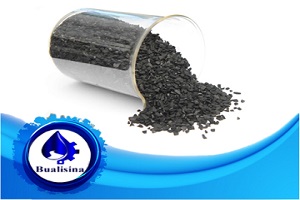Anthracite Coal
Anthracite Coal
Anthracite, often referred to as hard coal, is a hard, compact variety of coal that has a submetallic luster. It has the highest carbon content, the fewest impurities, and the highest energy density of all types of coal and is the highest ranking of coals.
Anthracite is the most metamorphosed type of coal (but still represents low-grade metamorphism), in which the carbon content is between 92% and 98%. The term is applied to those varieties of coal which do not give off tarry or other hydrocarbon vapours when heated below their point of ignition. Anthracite ignites with difficulty and burns with a short, blue, and smokeless flame.Anthracite is categorized into standard grade, which is used mainly in power generation, and high grade (HG) and ultra high grade (UHG), the principal uses of which are in the metallurgy sector. Anthracite accounts for about 1% of global coal reserves, and is mined in only a few countries around the world. Iran is one of them.Anthracite differs from ordinary bituminous coal by its greater hardness (2.75–3 on the Mohs scale), its higher relative density of 1.3–1.4, and luster, which is often semi-metallic with a mildly brown reflection. It contains a high percentage of fixed carbon and a low percentage of volatile matter. It is also free from included soft or fibrous notches and does not soil the fingers when rubbed. Anthracitization is the transformation of bituminous coal into anthracite.The moisture content of fresh-mined anthracite generally is less than 15 percent.
Sizing and grading
Anthracite is processed into different sizes by what is commonly referred to as a breaker. The large coal is raised from the mine and passed through breakers with toothed rolls to reduce the lumps to smaller pieces. The smaller pieces are separated into different sizes by a system of graduated sieves, placed in descending order. Sizing is necessary for different types of stoves and furnaces.
Anthracite is classified into three grades, depending on its carbon content. Standard grade is used as a domestic fuel and in industrial power-generation. The rarer higher grades of anthracite are purer – i.e., they have a higher carbon content – and are used in steel-making and other segments of the metallurgical industries. Technical characteristics of the various grades of anthracite are as follows:
Anthracite is divided by size mainly into applications that need lumps (typically larger than 10 mm) – various industrial processes where it replaces metallurgical coke, and domestic fuel – and those that need fines (less than 10 mm), such as sintering and pelletizing.
The common American classification by size is as follows:
Lump, steamboat, egg and stove coals, the latter in two or three sizes, all three being above 1 1⁄2 in (38 mm) size on round-hole screens.
High grade
High grade (HG) and ultra high grade (UHG) anthracite are the highest grades of anthracite coal. They are the purest forms of coal, having the highest degree of coalification, the highest carbon count and energy content and the fewest impurities (moisture, ash and volatiles). High grade and ultra high grade anthracite are harder than standard grade anthracite, and have a higher relative density. An example of a chemical formula for high-grade anthracite would be C240H90O4NS, representing 94% carbon. UHG anthracite typically has a minimum carbon content of 95%.
They also differ in usage from standard grade anthracite (used mainly for power generation), being employed mainly in metallurgy as a cost-efficient substitute for coke in processes such as sintering and pelletizing, as well as pulverized coal injection (PCI) and direct injection into blast furnaces. They can also be used in water purification and domestically as a smokeless fuel.
Advantages
Anthracite coal has several important advantages not only over other forms of coal, but over other energy producing materials in general. Its most important advantage is, of course, the fact that it produces very little pollution or soot, making it a very clean source of heat. Anthracite coal is also very efficient because only a small amount needs to be burnt to produce a large amount of energy. Additionally, there is a large supply of anthracite, over six billion tons in the Appalachian Mountains alone, with more reserves found in the Rocky Mountains and the Andes.
Disadvantages
Although anthracite coal has many advantages and has a variety of uses, it has several drawbacks. For example, anthracite coal is more expensive than other forms of coal due to its high quality. This is the primary reason that anthracite coal is not used in power plants or as a replacement to petroleum-based gasoline in automobiles. Anthracite coal is also more difficult to ignite than other forms of coal and requires a draft of air from beneath to catch fire. Despite this fact, however, anthracite coal is often the source of large underground fires that can burn for years or even decades and are often difficult to detect due to the lack of smoke.




Leave a Reply
Want to join the discussion?Feel free to contribute!